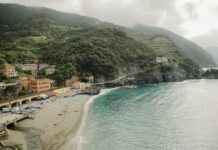Ardèche (07), Drôme (26), Gard (30), Pyrénées-Orientales (66) and Vaucluse (84): five departments have been placed under orange vigilance in the south of France.
They should go through a «new heatwave episode whose intensity and duration will be less than those of the previous episode», said Météo-France on Sunday in a bulletin.
The ten other departments in the south-eastern quarter of France have been placed on yellow alert.
A few days after an exceptional heat wave that lasted two weeks, temperatures were again high on Sunday afternoon from Roussillon to Provence.
– Heat peak on Wednesday –
“On this night from Sunday to Monday, the mildness is particularly marked on the coastal plains of Languedoc-Roussillon as well as in the Rhône valley.
At 5am it is still 27.2°C in Perpignan, 24.6°C in Nîmes-Coubressac, 25.5°C in Avignon, 23.6°C in Montélimar», noted Météo-France in its 6am bulletin.
“Monday afternoon, the temperatures will reach 35 to 38 degrees in the departments placed in orange vigilance with peaks at 39 degrees towards the Gard”, adds Météo-France, the heat peak being expected Wednesday across France metropolitan, «with highs often greater than or equal to 35°C and peaks at 39 or 40 degrees in the southwest».
This peak should however be «brief in many departments», according to Steven Testelin, forecaster at Météo France, and cooler air could arrive Thursday from the northwest.
South of Nîmes (Gard), fanned by the Mistral and the Tramontana, a fire destroyed 200 hectares of pine forest on Sunday evening, and four firefighters were injured, one seriously.
A large plume of gray and orange smoke required the partial closure of the A9 motorway.
The Gard had been placed on Saturday, for the first time this season, in «extreme danger» level for forest fires in the Gard Rhodanien area.
Another fire broke out late Sunday afternoon about twenty kilometers from Marseille, near Pennes-Mirabeau.
This multiplication of episodes of high heat is a direct consequence of global warming according to scientists, greenhouse gas emissions (linked to energy production, transport, industry) increasing both their intensity , their duration and frequency.
Météo France recommends watching over the elderly, people with chronic illnesses or mental health disorders, people who regularly take medication, and isolated people.
Dehydration or heat stroke (fever, hot, red and dry skin, headaches, nausea) can also affect athletes and people who work outdoors.
“The provisions of the ORSEC health management plan for heat waves are activated by the prefects according to local situations,” Matignon said in a press release on Monday.
«The Prime Minister (Elisabeth Borne) will regularly monitor the situation,» the statement said.
– Record drought –
France experienced its driest July since measurements began in August 1958, Météo France confirmed.
Western Europe faced a historic drought in July and two heat waves in barely a month, during which devastating forest fires broke out as in Gironde or now in Greece.
The Gironde prefecture has announced that the department will again be placed on red alert for the risk of fires, prohibiting the movement of people and vehicles in the forest between 2 p.m. and 10 p.m.
Access to the forests is also strictly prohibited in the Vaucluse, and in four of the 25 massifs of the Bouches-du-Rhône.
In the Jura, new water restrictions apply on Monday. The watering of lawns and any green space is prohibited, as is the filling of private swimming pools, or the washing of vehicles.















